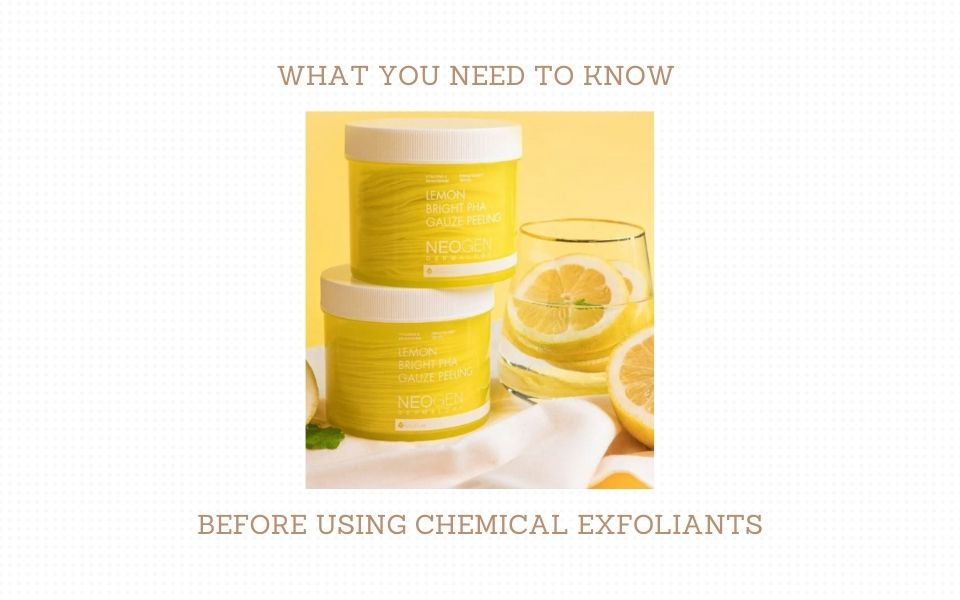Estimated Reading Time: 2 minutes
Chemical exfoliants can do wonders for skin. AHAs (Alpha Hydroxy Acids) can even out skin tone and give you smoother skin. BHAs (Beta Hydroxy Acids) work to unclog pores and get rid of excess oil. PHAs (Polyhydroxy Acids) are just as effective as AHAs but gentler on skin, making them ideal for sensitive skin.
When using chemical exfoliants, there are certain things to watch out for, such as over-exfoliating. Keep reading to learn the essentials about chemical exfoliants before adding them to your skin care routine.
Don’t rush into it
If you’re new to chemical exfoliants, it’s best to go easy and listen to your skin to figure out how best to use the product. Start by incorporating an exfoliant into your routine once a week before slowly building up to using it daily. Allow your skin to adjust – this reduces the chances of irritation. Once you feel that your skin can handle the product, then feel free to up the frequency to several times a week.
Start with a lower concentration
Beginners to chemical exfoliants and those with sensitive skin should opt for acids in low concentrations before working your way up. Going straight to using chemical exfoliants in high concentrations can damage the skin barrier and cause redness or inflammation. For AHAs, try not to go beyond 10% concentration; for BHAs, anything with a 0.5% to 2% concentration can deliver results.
For entry-level AHAs, give Beauty of Joseon’s Green Plum AHA Bubble Toner a try. Enriched with 3% glycolic acid and green plum water, this toner gently and effectively gets rid of dead skin cells and leaves you with softer, more radiant skin.
New to BHAs? Try adding celimax’s JIWOOGAE Heartleaf BHA Peeling Pad to your evening routine once a week. Formulated with BHAs, naturally derived heartleaf extract and hyaluronic acid, these peeling pads gently slough off dead skin cells and fight excess sebum while keeping skin hydrated.
AHAs in low concentration:
BHAs in low concentration:
You can use a chemical exfoliant day or night
Chemical exfoliants can be added to your morning or evening skin care routine. If you decide to use one during the day, then make sure to apply sunscreen afterward, particularly with AHAs as this exfoliant makes your skin more photosensitive.
To get the most out of a chemical exfoliant, incorporate it into your nighttime routine. Using AHAs or BHAs at night helps get rid of dead skin cells while repairing skin as you slumber. If your skin feels dull or rough, go for a product containing glycolic acid like COSRX’s AHA 7 Whitehead Power Liquid, and you’ll notice a brighter and smoother complexion in the morning.
For sensitive skin, stick to PHAs as they’re a lot gentler on skin than the other chemical exfoliants. NEOGEN offers a variety of peeling pads that are packed with PHAs and won’t irritate sensitive skin. In addition to exfoliating benefits, NEOGEN’s Dermalogy Green Tea Moist PHA Gauze Peeling pads offer soothing and moisturizing effects.
Under-exfoliating vs. Over-exfoliating
How do you know if you’re not exfoliating enough? Rough patches and uneven skin tone are signs that you’re under-exfoliating. To fix this, exfoliate more often.
Over-exfoliating can cause difficult and sometimes painful issues like irritation, redness, breakouts and increased sensitivity to skin care products. I’ve been guilty of over-exfoliating in the past even though I know the rules by now. Whenever it happens, I stop using any acids for at least two weeks to help my skin recover.
If you’ve over-exfoliated, take a break from chemical exfoliants and prioritize using hydrating and nourishing products for your skin. Look for ingredients like ceramides, hyaluronic acid or squalane to nurse your skin back to health.













